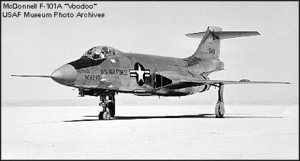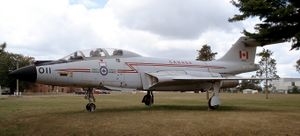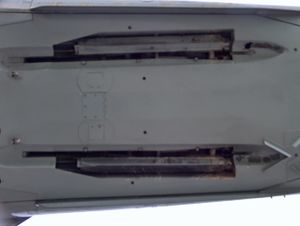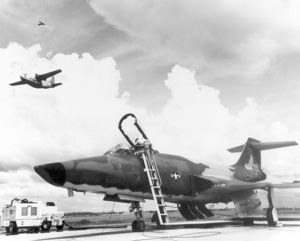PlaneSpottingWorld welcomes all new members! Please gives your ideas at the Terminal.
F-101 Voodoo
| F-101 Voodoo | |
|---|---|
| A two-seat McDonnell F-101B Voodoo | |
| Type | Fighter aircraft |
| Manufacturer | McDonnell Aircraft |
| Designed by | Edward M. Flesh[1] |
| Maiden flight | 29 September 1954 |
| Introduced | May 1957 |
| Retired | 1966, USAF 1982, US ANG 1984, Canada |
| Primary users | United States Air Force Royal Canadian Air Force/ Canadian Forces |
| Number built | 885 |
| Unit cost | US$1,276,145 (RF-101C)[2] US$1,754,066 (F-101B) |
| Developed from | XF-88 Voodoo |
| Variants | CF-101 Voodoo |
The McDonnell F-101 Voodoo was a supersonic military fighter flown by the USAF and the RCAF. Initially designed as a long-range bomber escort (known as a penetration fighter) for the Strategic Air Command, the Voodoo served in a variety of other roles, including the fighter bomber, all-weather interceptor aircraft and photo reconnaissance roles. Reconnaissance Voodoos saw extensive service during the Vietnam War.
Contents
Design and development
Initial design on what would eventually become the Voodoo began just after World War II in response to a USAAF Penetration Fighter Competition in 1946 for a long-range high performance fighter to escort bombers, much as the P-51 Mustang had done in its time. After being awarded a contract (AC-14582), McDonnell built two prototypes, designated the XF-88. The first prototype (#46-6525), powered by two Westinghouse XJ-34-WE-13 (3000 hp/2240 kW) flew from Muroc on 20 October 1948. Preliminary testing revealed that the top speed was a disappointing 640 mph (1,030 km/h) at sea level. After fitting McDonnell-designed afterburners, thrust was increased by 30% with corresponding performance increases in top speed, initial rate of climb and reduced takeoff distance.
Although the XF-88 won the "fly-off" competition against the competing Lockheed XF-90 and North American XF-93, the USAF (created in 1947) reevaluated the need for bomber escort and terminated the Penetration Fighter program in 1950. Analysis of Korean war missions, however, revealed that current USAF strategic bombers were vulnerable to fighter interception. In 1951, the USAF issued a new requirement for a bomber escort with all major US manufacturers submitting designs. The McDonnell design was a larger and higher powered version of the XF-88, and won the bid in May 1951. The F-88 was redesignated the F-101 Voodoo in November 1951.
Design work was relatively simple, as the only major change from the initial specification was to change the Westinghouse turbojets to a much more powerful Pratt & Whitney design. The new engines required certain changes to the intakes and a lengthened fuselage to triple the fuel load. The design was approved, and an order for 39 F-101As was placed in May 1953 without any prototypes built. Performance was considerably greater than the barely supersonic F-100 Super Sabre, but would fall short of later Mach 2 class fighters. However the Mach 1.7 performance is very comparable to the current McDonnell Douglas, now Boeing F/A-18E/F Super Hornet which trades off maximum speed for turning performance.
The first flight of the F-101A was on 21 September 1954. The end of the war in Korea and the development of the B-52 negated the need for fighter escort and Strategic Air Command withdrew from the program. The aircraft would be employed primarily as a two-seat air defence interceptor, nuclear fighter bomber and a reconnaissance platform which saw service over Cuba and Vietnam.
The Voodoo's replacement as a bomber would be the McDonnell Douglas F-4 Phantom II. While the Voodoo was a moderate success, it may have been more important as an evolutionary step towards the Phantom, the most versatile and successful western fighter design of the 1960s if not all time. The Phantom would retain the twin engines, twin crew for interception duties, and a tail mounted well above and behind the jet exhaust.
Operational history
F-101A / RF-101G
Despite SAC's loss of interest, the aircraft attracted the attention of Tactical Air Command, and the F-101 was reconfigured as a fighter bomber, intended to carry a single nuclear weapon for use against battlefield targets such as airfields. With the support of TAC, testing was resumed, with Category II flight tests beginning in early 1955. A number of problems were identified during development. Many of these were fixed although the aircraft had a dangerous tendency toward severe pitch-up at high angle of attack that was never entirely solved. Around 2,300 improvements were made to the aircraft in 1955-56 before full production was resumed in November 1956.
The first F-101A was delivered in May 1957 to the 27th Strategic Fighter Wing, replacing their F-84F Thunderstreak. The F-101A had two P&W J57-P-13 turbojets, each with 10,200 lbf (45.4 kN) dry and 15,000 lbf (66.7 kN) afterburning thrust. It had MA-7 fire-control radar for both air-to-air and air-to-ground use, augmented by an MA-2 toss-bombing system for delivering nuclear weapons. It was fitted with four M39 cannon, and designed to carry a Mk 28 nuclear bomb (although it was theoretically capable of carrying conventional bombs or rockets, the Voodoo never used such weapons operationally). In service, one cannon was often removed to make room for a TACAN beacon receiver.
F-101 was the first aircraft in USAF inventory capable of exceeding 1000 mph in level flight. There were a number of speed records set by the Voodoo: a JF-101A set a world speed record of 1,942 km/h (1,207 mph) on December 12, 1957, handily beating the previous Fairey Delta 2 record, an RF-101A flew Los Angeles-New York-Los Angeles route in 6 hours, 46 minutes, and an F-101A flew from Carswell, Texas to Bermuda without refueling.
A total of 77 F-101As were built. They were gradually withdrawn from service starting in 1966. Twenty-nine survivors were converted to RF-101G specifications with reconnaissance cameras in place of cannons and radar. These served with the Air National Guard through 1972.
RF-101A
In October 1953, the USAF requested that two F-101As be built as prototype YRF-101A tactical reconnaissance aircraft. These were followed by 35 RF-101A production aircraft. The RF-101A shared the airframe of the F-101A including its 6.33 g (62 m/s²) limit but replaced the radar and cannons with up to six cameras in the reshaped nose. It was unusual in having provision for both flying boom and probe-and-drogue in-flight refueling. RF-101A entered service in May 1957, replacing the RB-57 Canberra.
USAF RF-101As flew reconnaissance sorties over Cuba during the Cuban Missile Crisis in October 1962.
In October 1959 eight RF-101As were transferred to Taiwan, which used them for overflights of the Chinese mainland. Two were reportedly shot down.
F-101B / CF-101B / EF-101B
In the late 1940s, the Air Force had started a research project into future interceptor aircraft that eventually settled on an advanced specification known as the 1954 Interceptor. Contracts for this specification eventually resulted in the selection of the F-102, but by 1952 it was becoming clear that none of the parts of the specification other than the airframe would be ready by 1954: the engines, weapons and fire control systems were all going to take too long to get into service. An effort was then started to quickly produce an interim supersonic design to replace the various subsonic interceptors then in service, and the F-101 airframe was selected as a starting point.
Although McDonnell proposed the designation F-109 for the new aircraft (which was to be a substantial departure from the basic Voodoo), the USAF assigned the designation F-101B. The Voodoo was modified to carry a crew of two, with a larger and more rounded forward fuselage to hold a Hughes MA-13 fire control radar. It had transponders linking it to the Semi-Automatic Ground Environment (SAGE) system, allowing it to be steered onto targets by ground controllers. The F-101B had uprated P & W J57-P-55 engines each with 11,990 lbf (53.34 kN) dry and 16,900 lbf (75.2 kN) afterburning thrust, making it the only Voodoo not using the -13 engines. The new engines were substantially longer than J57-P-13s and to avoid a major redesign the afterburners were simply allowed to extend out of the fuselage by almost 8 ft (2.4 m).
The F-101B had no cannons, instead, it carried four Falcon air-to-air missiles on a rotating door in the fuselage weapons bay. Initial load was two GAR-1 (AIM-4A) semi-active radar homing and two GAR-2 (AIM-4D) infrared-guided weapons. After the first two missiles were fired, the door turned over to expose the second pair. Standard practice was to fire the weapons in SARH/IR pairs to increase the likelihood of a hit. Late-production models had provision for two MB-1/AIR-2 Genie nuclear rockets in place of two of the Falcons, and Project "Kitty Car" upgraded most earlier F-101Bs to this standard beginning in 1961.
From 1961 through 1966, F-101Bs were upgraded under Project 'Bright Horizon,' fitting them with a retractable infrared sighting and tracking (IRST) system in the nose in place of the standard in-flight refueling probe.
The F-101B was made in greater numbers than the F-101A with a total of 479 being delivered by the end of production in 1961. Most of these were delivered to Air Defense Command beginning in January 1959. The only foreign customer for the F-101B was Canada. For more details on the history of the Voodoo in Canada, see CF-101 Voodoo.
The F-101B was withdrawn from ADC service from 1969 to 1972. Surviving USAF aircraft were transferred to the Air National Guard, where they served until 1982.
TF-101B / F-101F / CF-101F
Some of the F-101Bs were completed as dual-control operational trainer aircraft initially dubbed TF-101B but later redesignated F-101F. Seventy-nine new-build F-101Fs were manufactured, and 152 more existing aircraft were later modified with dual controls. Ten of these were supplied to Canada under the designation CF-101F. These were later replaced with 10 updated aircraft in 1971.
RF-101B
In the early 1970s, a batch of 22 ex-RCAF CF-101Bs were returned to the USAF and converted to RF-101B reconnaissance aircraft with radar and weapons bay replaced with a package of three KS-87B cameras and two AXQ-2 TV cameras. An in-flight refueling boom receptacle was fitted. These aircraft served with the 192nd Tactical Reconnaissance Squadron of the ANG through 1975. They were expensive to operate and maintain and had a short service life.
F-101C / RF-101H
The F-101A fighter-bomber had been accepted into Tactical Air Command service despite a number of problems. Among others, its airframe had proven to be capable of withstanding only 6.33 g (62 m/s²) maneuvers rather than the intended 7.33 g (72 m/s²). An improved model, the F-101C, was introduced in 1957. It had a 500 lb (227 kg) heavier structure to allow 7.33 g maneuvers as well as a revised fuel system to increase the maximum flight time in afterburner. There were no external differences between F-101A and F-101C other than the serial numbers. Forty-seven were produced.
The F-101C was stationed in the United Kingdom to be within closer striking range of Soviet and Warsaw Pact forces. Originally serving with the 27th Tactical Fighter Wing, the aircraft were transferred to the 81st Tactical Fighter Wing which operated three squadrons from RAF air station Bentwaters/Woodbridge. Both F-101A/C aircraft were assigned to the 81st. Operational F-101A/C were upgraded in service with Low Angle Drogued Delivery (LADD) and Low Altitude Bombing System (LABS) equipment for its primary mission of delivering nuclear weapons at extremely low altitudes. Pilots were trained for one-way missions into Soviet territory to increase effective range at some cost in negating pilot recovery.
The F-101C never saw combat and was replaced in 1966 with the F-4C Phantom II. 32 aircraft were later converted for unarmed reconnaissance use under the RF-101H designation. They served with Air National Guard units until 1972.
RF-101C
Using the reinforced airframe of the F-101C, the RF-101C first flew on 12 July, 1957, entering service in 1958. Like RF-101A, RF-101C had six cameras in place of radar and cannons in the reshaped nose. Unlike the RF-101A, the RF-101C retained the ability to carry a single nuclear weapon on the centerline pylon. 166 were built, including 96 originally scheduled to be F-101C fighter-bombers.
The 1964 Project "Toy Tiger" fitted some RF-101C with a new camera package and a centerline pod for photo-flash cartridges. Some were further upgraded under the Mod 1181 program with automatic control for the cameras.
The RF-101C saw service during the Cuban Missile Crisis and was sent to Vietnam in 1961, becoming the first USAF jet aircraft to serve there. RF-101C saw heavy service during the Vietnam War, losing the first F-101 in November 1964 to ground fire. From 1965 through November 1970, it's role was gradually replaced by the RF-4C Phantom II. In some 35,000 sorties, 44 aircraft were lost -- 31 to anti-aircraft fire, five to SAMs, one to an airfield attack, six to operational accidents, and one in air combat to a Mig-21 in September 1967. The RF-101C's speed made it largely immune to MiG interception. In April 1967, ALQ-71 ECM pods were fitted to provide some protection against SAMs. Although the Voodoo was again able to operate at medium altitudes, the added drag decreased the speed enough to make RF-101 vulnerable to MiGs and thus requiring fighter escort.
After withdrawal from Vietnam, the RF-101C continued to serve with USAF units through 1979.
In service, the RF-101C was nicknamed "Long Bird;" it was the only Voodoo to see combat.
Variants
- F-101A - initial production fighter bomber, 77 produced.
- NF-101A - one F-101A used by General Electric for testing of the General Electric J79 engine.
- YRF-101A - two F-101As built as prototype reconnaissance models.
- RF-101A - first reconnaissance version, 35 built.
- F-101B - two-seat interceptor, 479 built.
- CF-101B - 112 F-101Bs transferred to Royal Canadian Air Force (RCAF).
- RF-101B - 22 ex-RCAF CF-101B modified for reconnaissance use.
- TF-101B - dual-control trainer version of F-101B, redesignated F-101F, 79 built.
- EF-101B - single F-101B converted for use as a radar target and leased to Canada.
- NF-101B - F-101B prototype based on the F-101A airframe; the second prototype was built with a different nose.
- F-101C - improved fighter-bomber, 47 built.
- RF-101C - reconnaissance version of F-101C airframe, 166 built.
- F-101D - proposed version with General Electric J79 engines, not built.
- F-101E - another J79 proposal, not built.
- F-101F - dual-control trainer version of F-101B; 79 redesignated TF-101Bs plus 152 converted F-101B.
- CF-101F - RCAF designation for 20 TF-101B/F-101F dual-control aircraft.
- TF-101F - 24 dual-control versions of F-101B, redesignated F-101F (these are included in the -F total).
- RF-101G - 29 F-101As converted for ANG reconnaissance.
- RF-101H - 32 F-101Cs converted for reconnaissance use.
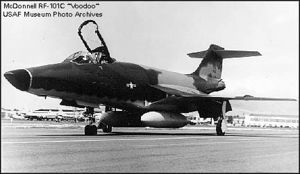
Operators
Survivors
Below is a list of museums with an F-101(CF-101) in their collection:
- Air Force Heritage Park, Winnipeg, Manitoba (CF-101B)
- Alberta Aviation Museum, Edmonton, Alberta (CF-101B)
- Atlantic Canada Aviation Museum, Halifax, Nova Scotia (CF-101)
- Bagotville Commemorative Park, Saguenay, Quebec (CF-101)
- Canadian War Museum, Ottawa, Ontario (CF-101F)
- Canada Aviation Museum, Ottawa, Ontario (CF-101B)
- Carolinas Aviation Museum, Charlotte, North Carolina (F-101B)
- Comox Air Force Museum, Comox, British Columbia (CF-101)
- National Museum of the Air Force, Dayton, Ohio (F-101B, RF-101C)
- McChord Air Museum, McChord AFB, Washington (CF-101F)
- The Museum of Aviation, Warner-Robins, Georgia (F-101F and RF-101C)
- North Atlantic Aviation Museum, Gander, Newfoundland (CF-101B)
- Shearwater Aviation Museum, Dartmouth, Nova Scotia (CF-101B In storage)
- Western Canada Aviation Museum, Winnipeg, Manitoba (CF-101B)
- Peterson Air & Space Museum, Colorado Springs, CO (CF-101B S/N101044 [former USAF S/N 57-0381]) & (F-101B S/N 58-0274)
- Castle Air Museum, Atwater, CA (F-101B S/N 57-0412)
- MAPS AIR MUSEUM, N. Canton, OH (F-101 in storage)
- March Field Museum, Riverside, CA (F-101B S/N 59-0418)
- Strategic Air & Space Museum, Ashland, NE, (F-101B S/N 59-0462)
- Yankee Air Museum, Belleville, MI, (F-101?)
- Chanute Air Museum, Rantoul, Il, (F-101B S/N 56-0273)
- Travis Air Museum, Travis AFB, CA (F-101B)
- Pima Air Museum, Tucson, AZ, (F-101B)
Specifications (F-101B)
Data from The Great Book of Fighters[3]
General characteristics
- Crew: 2
- Length: 67 ft 5 in (20.55 m)
- Wingspan: 39 ft 8 in (12.09 m)
- Height: 18 ft 0 in (5.49 m)
- Wing area: 368 ft² (34.20 m²)
- Airfoil: NACA 65A007 mod root, 65A006 mod tip
- Empty weight: 28,495 lb (12,925 kg)
- Loaded weight: 45,665 lb (20,715 kg)
- Max takeoff weight: 52,400 lb (23,770 kg)
- Powerplant: 2× Pratt & Whitney J57-P-55 afterburning turbojets
- Dry thrust: 11,990 lbf (53.3 kN) each
- Thrust with afterburner: 16,900 lbf (75.2 kN) each
- * Internal fuel capacity: 2,053 US gal (7,771 L)
- Fuel capacity with 2 external tanks: 2,953 US gal (11,178 L)
Performance
- Maximum speed: Mach 1.72 (1,134 mph, 1,825 km/h) at 35,000 ft (10,500 m)
- Range: 1,520 mi (1,320 nm, 2,450 km)
- Service ceiling: 58,400 ft (17,800 m)
- Rate of climb: 49,200 ft/min (250 m/s)
- Wing loading: 124 lb/ft² (607 kg/m²)
- Thrust/weight: 0.74
Armament
- Missiles:
- 4× AIM-4 Falcon
- 2×AIR-2 Genie nuclear rockets
Avionics
- Hughes MG-13 fire control system
References
- Francillon, Réne J. "It's Witchcraft: McDonnell's F-101 Voodoo." Airpower: Vol. 10, no. 3. May 1980.
- Green, William and Swanborough, Gordon. The Great Book of Fighters. St. Paul, Minnesota: MBI Publishing, 2001. ISBN 0-7603-1194-3.
- Hobson, Chris. Vietnam Air Losses: United States Air Force, Navy and Marine Corps Fixed-Wing Aircraft Losses in Southeast Asia, 1961-73. North Branch, Minnesota: Specialty Press, 2002. ISBN 1-85780-1156.
- Knaack, Marcelle Size. Encyclopedia of US Air Force Aircraft and Missile Systems: Volume 1 Post-World War II Fighters 1945-1973. Washington, DC: Office of Air Force History, 1978. ISBN 0-912799-59-5.
External links
- USAF Museum: Information on XF-88, F-101B in collection, RF-101C in collection, and information on the F-101B, and the RF-101A and C.
- 58th & 60th FISRG (Fighter-Interceptor Squadrons Reunion Group) http://www.fisrg.com - an actively maintained website devoted to the F-101B and the USAF military personnel of the 58th and 60th Fighter-Interceptor Squadrons that were located at Otis AFB on Cape Cod, MA, USA from 1959 to 1971. The histories of all F101s produced (by tail number, compiled by Joe Baugher) can be found in the section located at http://www.fisrg.com/F101info.html.
Related content
Related development
Comparable aircraft
Designation sequence
Related lists
See also
Fighters: XP-67 · FH · F2H · XF-85 · XF-88 · F3H · F-101 · F-110 · F-4 · F-15 · F/A-18 · CF-188 · YF-23 · F/A-18E/F
Attack: AH · AV-8 · F-15E · A-12 - Trainers: T-45
Transports: C-9 · KC-10 · YC-15 · C-17
Helicopters: XHJH · XH-20 · XHCH · XHRH · AH-64
Drones: TD2D · KDH - Experimental: XV-1 · X-36 · Bird of Prey - Spacecraft: Mercury · Gemini
Lists relating to aviation | |
|---|---|
| General | Timeline of aviation · Aircraft · Aircraft manufacturers · Aircraft engines · Aircraft engine manufacturers · Airports · Airlines |
| Military | Air forces · Aircraft weapons · Missiles · Unmanned aerial vehicles (UAVs) · Experimental aircraft |
| Notable incidents and accidents | Military aviation · Airliners · General aviation · Famous aviation-related deaths |
| Records | Flight airspeed record · Flight distance record · Flight altitude record · Flight endurance record · Most produced aircraft |
cs:F-101 Voodoo de:McDonnell F-101 fr:McDonnell F-101 Voodoo it:McDonnell F-101 Voodoo ja:F-101 (戦闘機) no:McDonnell F-101 Voodoo ru:McDonnell F-101 Voodoo fi:F-101 Voodoo
